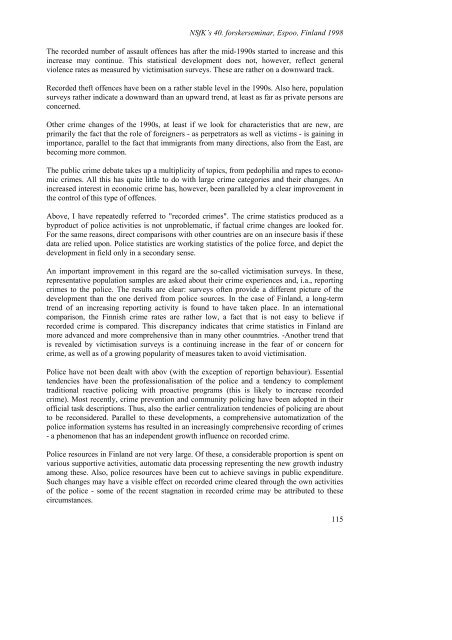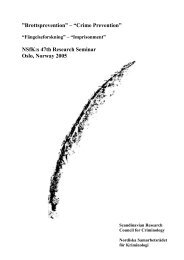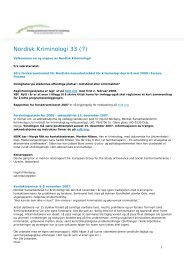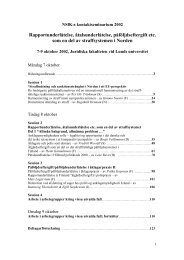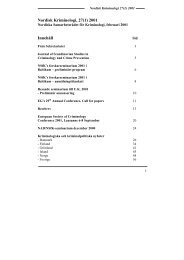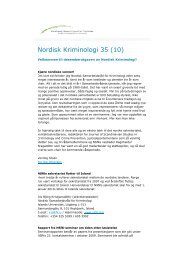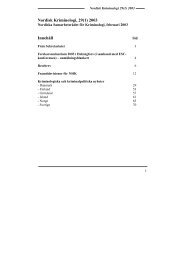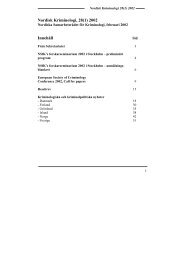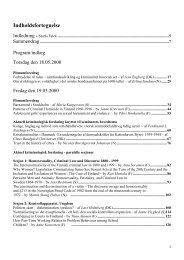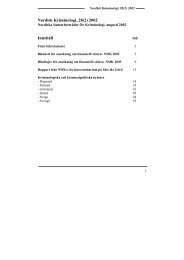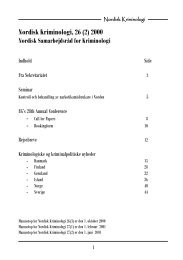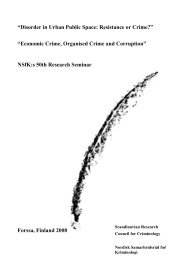Organised Crime & Crime Prevention - what works? - Scandinavian ...
Organised Crime & Crime Prevention - what works? - Scandinavian ...
Organised Crime & Crime Prevention - what works? - Scandinavian ...
You also want an ePaper? Increase the reach of your titles
YUMPU automatically turns print PDFs into web optimized ePapers that Google loves.
NSfK’s 40. forskerseminar, Espoo, Finland 1998<br />
The recorded number of assault offences has after the mid-1990s started to increase and this<br />
increase may continue. This statistical development does not, however, reflect general<br />
violence rates as measured by victimisation surveys. These are rather on a downward track.<br />
Recorded theft offences have been on a rather stable level in the 1990s. Also here, population<br />
surveys rather indicate a downward than an upward trend, at least as far as private persons are<br />
concerned.<br />
Other crime changes of the 1990s, at least if we look for characteristics that are new, are<br />
primarily the fact that the role of foreigners - as perpetrators as well as victims - is gaining in<br />
importance, parallel to the fact that immigrants from many directions, also from the East, are<br />
becoming more common.<br />
The public crime debate takes up a multiplicity of topics, from pedophilia and rapes to economic<br />
crimes. All this has quite little to do with large crime categories and their changes. An<br />
increased interest in economic crime has, however, been paralleled by a clear improvement in<br />
the control of this type of offences.<br />
Above, I have repeatedly referred to "recorded crimes". The crime statistics produced as a<br />
byproduct of police activities is not unproblematic, if factual crime changes are looked for.<br />
For the same reasons, direct comparisons with other countries are on an insecure basis if these<br />
data are relied upon. Police statistics are working statistics of the police force, and depict the<br />
development in field only in a secondary sense.<br />
An important improvement in this regard are the so-called victimisation surveys. In these,<br />
representative population samples are asked about their crime experiences and, i.a., reporting<br />
crimes to the police. The results are clear: surveys often provide a different picture of the<br />
development than the one derived from police sources. In the case of Finland, a long-term<br />
trend of an increasing reporting activity is found to have taken place. In an international<br />
comparison, the Finnish crime rates are rather low, a fact that is not easy to believe if<br />
recorded crime is compared. This discrepancy indicates that crime statistics in Finland are<br />
more advanced and more comprehensive than in many other counmtries. -Another trend that<br />
is revealed by victimisation surveys is a continuing increase in the fear of or concern for<br />
crime, as well as of a growing popularity of measures taken to avoid victimisation.<br />
Police have not been dealt with abov (with the exception of reportign behaviour). Essential<br />
tendencies have been the professionalisation of the police and a tendency to complement<br />
traditional reactive policing with proactive programs (this is likely to increase recorded<br />
crime). Most recently, crime prevention and community policing have been adopted in their<br />
official task descriptions. Thus, also the earlier centralization tendencies of policing are about<br />
to be reconsidered. Parallel to these developments, a comprehensive automatization of the<br />
police information systems has resulted in an increasingly comprehensive recording of crimes<br />
- a phenomenon that has an independent growth influence on recorded crime.<br />
Police resources in Finland are not very large. Of these, a considerable proportion is spent on<br />
various supportive activities, automatic data processing representing the new growth industry<br />
among these. Also, police resources have been cut to achieve savings in public expenditure.<br />
Such changes may have a visible effect on recorded crime cleared through the own activities<br />
of the police - some of the recent stagnation in recorded crime may be attributed to these<br />
circumstances.<br />
115


